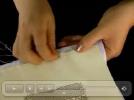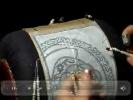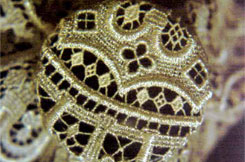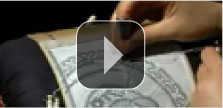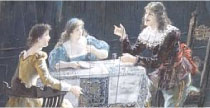
THE TROUSSEAU
Instrumentum, according to a Latin definition, simply means a supply of goods, of any kind and quantity, necessary for an activity: the equipment for a boarder, a soldier or a bride. Anyway the wedding trousseau has always had a great cultural and social importance: it is a sort of detailed and reliable mirror of the times which shows the evolution of taste and customs. It was generally the essential part of the dowry composed of money and various types of goods and, sometimes, it constituted the bulk of the “property” that the bride, since ancient times, had to bring with her in order to make the marriage possible.
The trousseau as a social property
A sumptuous trousseau was not only an individual matter of prestige for the family (it was publicly shown before the marriage), but for the community it was a guarantee of the social standing of the bride, because it proved the “marriageable” status of a female member of society and it was a clear sign of order and social stability. Sometimes the community took it upon themselves to supply a “basic” trousseau for the least well-off girls. On this point, you can read the report of the age-old Venetian feast “delle Marie” in the book “C’era una volta il corredo da sposa” (Once upon a time there was the marriage trousseau) by Doretta Davanzo Poli (ed. Consorzio Merletti di Burano, 1987).
The tradition of St. Nicholas
The theme of the social value of trousseaus is also at the basis of the tradition of St. Nicholas, famous for his custom of giving gifts and later transformed into the imaginary character of Santa Claus. In Buonarroti House in Florence, it is still possible to see Giovanni di Francesco’s (1428? – 1459) painting Storie di San Nicola di Bari (History of Saint Nicholas of Bari) with the famous episode of the Saint who is throwing three gold balls into the houses of three poor girls, who have fallen into poverty, in order to give them a dowry which can save them from social rejection and a sinful life. Therefore the “status” of the trousseau was strictly connected with the fact of being a woman in a structured social group. If a woman didn’t get married her trousseau was handed down to someone else. It was subject to an ancient law called collazione (collation), according to which the trousseau had to be included in the hereditaments, unless there were specific instructions in the will.
Convent trousseaus
Even nuns and abbesses had their own trousseaus. In the Museum of Palazzo Davanzati in Florence there are some special “chests for nuns” big rounded chests, specially made for those girls who were destined for a religious life.
Trousseaus and social stability
Actually the trousseau and dowry have always guaranteed the marriage would last, because the property in question would go back to the woman in case the marriage was dissolved. The property was managed by the husband, who was not allowed to sell anything, but if the bride died and there were no heirs, it went back to her father.
Different types of trousseaus
In the history of trousseaus, apart from the number of items, there were also differences in the contents, depending on whether the trousseau belonged to wealthy or less well-off people. The latter generally included bed linen in their trousseaus, while rich people preferred to have plenty of clothes, accessories and fabrics for the future needs of the bride and her family. According to the Jewish tradition the husband has to bring the household and bed linen, while the bride brings underwear garments. Sheets, which made their appearance in Byzantine times, were included quite late, but Boccaccio in one of his tales of “Novellino”, written between 1281 and 1300, already mentioned silk sheets; and, after 1870, also coloured silk underwear and sheets appeared.
Famous trousseaus
Some historical trousseaus are famous for their richness and sumptuousness (in particular Lucrezia Borgia’s who in 1502 married Alfonso d’Este, future Duke of Ferrara, and whose list of items can be found at the State Archives of Modena), anyway, the quantity of items of the same kind included in the trousseau greatly changes according to the period. For example in 1466 Nannina de’ Medici, Lorenzo the Magnificent’s sister, who married Bernardo Rucellai, had a trousseau which was considered “very rich”, with about ten dresses, only one “renza” white linen shirt (valuable thin white linen, from Reims), four pairs of gloves and eight of stockings and an embroidered fan (as well as bonnets and hats). (A. Fiorentini Capitani and S. Ricci: “Il costume al tempo di Pico e Lorenzo il Magnifico”, ed. Charta 1994) (Clothes at the time of Pico and Lorenzo the Magnificent), but in the Venetian trousseau of a bride called Priuli Tiepolo in 1788 there were 134 shirts (more than 30 nightgowns). It has been estimated that the quite rich but not extraordinary trousseau which belonged to the Raggi sisters from Genoa, between 1824 and 1830, was worth a 150-square-metre flat or a 17-ton fishing boat. (Doretta Davanzo Poli: “C’era una volta il corredo da sposa”). (Once upon a time there was the marriage trousseau).
Precious trousseaus
Royal and princely trousseaus mainly consisted of formal dresses with precious decorations, jewels and high quality accessories. In the 15th century embroidered and bejewelled sleeves came into vogue (they could also be removed and replaced with others) and whole fortunes were squandered on them. Laws were passed to solve this problem and churchmen reprimanded people for this habit. St. Bernardine of Siena fiercely attacked this custom and he was not moved by the fact that the sleeves looked like angels’ wings. (M. Luciana Buseghin: “Ricamo di nozze” (Wedding embroidery) – ed. Caprai, 1987). But more than the jewels, what made the trousseau particularly precious and expensive was the use of lace, starting with the wonderful “punto in aria” (stitch in air). It first appeared in Venice in the 15th century, devised by Venetian lace makers who have been a point of reference all over Europe for centuries, and at the end of the century it was produced in gold and silver and used as a decoration for clothes. From papal Rome to the elegant Este court, Lucrezia Borgia spread the passion for lace often made with precious metals in contrast with black clothes and coloured silk, in accordance with the Spanish taste of the Borgia family. (M. Luciana Buseghin: “Ricamo di nozze” (Wedding embroidery) – ed. Caprai, 1987).
The preparation of the trousseau
Apart from princely ones, in the past trousseaus were generally handsewn at home, with the exception of some particularly valuable items (because they were embroidered and decorated with lace) which were produced in “specialized” places like convents. The nuns also had the function of preserving and handing down the necessary techniques and skills, especially after the trousseau in white became popular in the last years of the 18th century. Starting from the beginning of the 20th century a lot of specialized firms have been proposing catalogues and estimates for various types of trousseaus.
Evolution and transformation of trousseaus
In time trousseaus have become much smaller (a dozen….. half a dozen items of the same kind) and they have lost their social function (because of consumerism, the quick changes in fashion, the new trend to invest in a house or furniture, considered more attractive). Now people show new interest in “special items”, selected textiles which have a particular cultural value or design and may be included in the “trousseau” of the future bride (or future bridegroom); they can represent a sort of link with the family or the community the future spouses are leaving; something to use every day (and, why not?, to hand down) as a special furnishing item for the new house and social reality.
Virtual Museum:
Room n. 3 An open trousseau chest, in which you can see part of its precious contents, is set between two windows in an early 17th-century palace in Florence. The scene recreates the home environment of a family in the Medici entourage: a hall in an aristocratic palace with a bed alcove. A maid is dressing up a sitting young lady, who is getting ready for her wedding ceremony. It seems lace and precious decorations have been taken from the girl’s trousseau chest and lie everywhere in the room. The mother is sitting by the fireplace looking after a baby girl and reading a book : “Description of a very happy marriage……”, by Michelangelo Buonarroti (nephew of his more famous relative having the same name), concerning the newly celebrated marriage (in the year 1600) between Maria de’ Medici and Henry IV of France.
FROM EMBROIDERY TO LACE
What is true for works of art which are deeply affected by the historical context, clients, political relationships, customs, bonds, morals, etc….., is valid for lace too which is the result of a continuous evolution and not just part of a lost art which can only be reproduced. In 1939 Coco Chanel wrote: “unlike many other precious objects which, owing to industrial progress, have lost much of their luxurious quality, lace, adapting itself to the economic and industrial requirements of our age, has kept its main characteristics: precious elegance, lightness and luxury”.
Main differences between embroidery and lace, The first needle lace
Il primo merletto ad ago
We can say that embroidery is an age-old art, even if the popularity of embroidery in white is quite recent (starting from the 18th-century neoclassical period) and has changed greatly in time (in the past coloured embroidery, which also included the use of gold and silver threads, pearls and precious stones, was performed exclusively by men), lace, on the contrary, originated in the 15th century and was a direct evolution of the drawn thread work. In practice, the research of new embroidery techniques and effects and the Renaissance experimentation, brought to wider and wider unthreaded spaces between weft and warp, in order to have larger parts to fill in with embroidery; until someone realized that it was possible to create a new marvel “from nothing” needless of any fabric support. Obviously reticella was fundamental for the appearance of needle lace and it was also the turning point in the transition from drawn thread work to real lace. It still presented the orthogonal framework of weft and warp and very geometric decorative motives both because they were typical of the early Renaissance iconography and because they were easier to make. Only when the first real type of needle lace, il punto in aria (stitch in air), became popular, it was possible to create the first flowery motives and the amazing folds of very large ruffs which became very common between the end of the 16th and the beginning of the 17th century, still having reticella as an internal support.
Bobbin lace
The “needle” technique was immediately followed by the appearance of bobbin lace (made by twisting several threads, while the weaving is held in place with pins set in a lace pillow) whose results were equally valuable. The two techniques have always enjoyed great popularity, with one temporarily outstripping the other owing to the fashion requirements and the culture of the period.
Scene based on Jacopo Strada’s 16th-century engravings, symbolizing the first appearance of lace. Under the “portego” (porch) of a Venetian Palace (the representation hall on the main floor, open on both sides) three girls are engaged in an embroidery and lace job-pastime. One in particular is drawing threads out of a piece of material, while the others are looking at the reticella hem of a small tablecloth.
WHEN LACE APPEARED IN TROUSSEAUS
Lace has always been a fundamental element of the sumptuous trousseaus of noble families, together with jewels and considered as precious as them. It was mainly used as a decoration of collars and sleeve cuffs, both for women and men, and it became so important as a status symbol of upper classes as to be represented also on armours. Moreover we must consider that designing and making lace was one of the very few activities a Renaissance woman could devote herself to: there were very few women painters and poetesses and they were generally courtesans. Even Catherine de’ Medici (with one of the most lavish trousseaus of the 16th century), who married the future King Henry II of France, clever stateswoman and with a firm hand, mother of three French kings, was often seen with her precious lacework in her hands going around the halls of Chambord or Blois castles...
Trousseaus for middle and popular classes
If we take into consideration middle-class trousseaus (with the exception of particular cases, like Holland, where the middle classes actually replaced the aristocracy, starting from the 17th century) and the ones popular classes could afford, we can see that items decorated with precious lace started to appear only in the 19th century, also as a consequence of the growing interest of people in trousseaus and the invention of new machinery for lace-making. Anyway the transition was quite gradual: in fact it often happened that unfashionable lace, which had been used several times, was given by a lady to her faithful maid as a present or, sometimes, it was even left as a legacy.
In the 19th century also “alternative lace” appeared, different from needle or bobbin lace, easier and faster to make and consequently often produced at home. An example is Irish lace, created with a crochet hook using such a thin thread as to give the impression of a 17th-century Venetian lace. Irish lace, which takes its name from the country were it was first devised, became very common and in 1904 it was introduced onto Isola Maggiore on Lake Trasimeno (Umbria) where there is a nice small lace museum still open to the public.
Virtual Museum:
Room n. 2: 16th-century scene representing noble Venetian young girls, under a portego (porch), engaged in preparing their trousseaus. Room n. 3: 17th-century home environment belonging to the Medici entourage, with an open trousseau chest. Room n. 6: a middle-class Dutch family having tea (early 18th-century). Room n. 13: popularity of trousseaus – Queen Margherita visiting Burano school and laboratory (second half of the 19th century). Room n. 14: fishermen’s house interior on the Isola Maggiore (Trasimeno Lake/Umbria) with a group of women engaged in making Irish lace (first half of the 20th century).
WHEN LACE APPEARED IN HOME FURNISHINGS (TABLECLOTHS, DOILIES)
Lace was used very early as a decoration for tablecloths and table runners: we can find several, even sumptuous, examples starting from the 16th century. This happened because in Italy (and, generally speaking in central Europe) tablecloths, besides being a status symbol representing the wealth of the landlord and which could be shown off together with clothes, had also a cultural value. Actually, more than the table (with the exception of fratini (fratino tables) in monasteries, real dining tables appeared only in the 18th century), the tablecloth was the real symbol of the users’ social rank. As important guests used to wipe their hands on the tablecloth, tablecloths were arranged in layers and removed, one after the other, together with dirty dishes. A striking example can be found in the “Convito a casa di Levi” (Banquet at Levi’s House), a large canvas painted by Paolo Veronese in 1573 and now at the Gallerie dell’Accademia in Venice, where the tablecloth is decorated with large precious lace.
As lace was very precious, it appeared much later in curtains and other home furnishings (braid decorations were generally used), also because until the 18th century home interiors were not permanently furnished.
Virtual Museum:
Tablecloths decorated with lace can be found in the following rooms: Room n. 3: interior of an early 17th-century Palace in Florence.Room n. 4: presentation of the point de France to the Sun King (Parisian environment referring to Versailles, about 1680).Room n.6: early 18th-century middle-class Dutch interior. Room n. 7: chocolate at Madame de Pompadour’s Petit Appartaments in Versailles.Room n. 13: interior of Burano school and laboratory, second half of the 19th century.
WHEN LACE APPEARED IN VESTMENTS AND ALTAR CLOTHS
We can make a distinction between the appearance of lace as a decoration for table cloths and vestments. For what concerns the former there has always been an osmotic relationship between dining tablecloths and altar cloths. We mustn’t forget that the Holy Eucharist was instituted to celebrate the memory of the Last Supper and all laid tables, at least in paintings and frescoes until mid-15th century, referred to religious subjects: the Last Supper, the Supper at Emmaus, the Wedding at Cana, the Banquet at Levi’s House. Probably tovaglie perugine (tablecloths from Perugia) (see Room No. 1) originally were altar cloths. Sometimes it is difficult to say whether a small 16th-century tablecloth, with reticello e punto in aria (reticella and stitch in air), was an altar cloth or a dining tablecloth.
For what concerns the use of lace as a decoration of upper clergy vestments, it keeps pace with its use in fashionable clothes. It first appeared in the 16th century and had an enormous growth at the beginning of the 17th century, as a consequence of that “need to show off” which was the distinctive characteristic of the whole century. Wonderful punto in aria (stitch in air) lace flounces trim the clothes of Pope Paul III Farnese (1534-49) and of cardinal Ferdinand de’ Medici (later Grand Duke Ferdinand I), in the painting made in 1588 and now at the Uffizi (by a painter belonging to the circle of Alessandro Allori); also the lace in the portrait of cardinal Bentivoglio painted by Van Dyck between 1622 and 1623 (Florence, Pitti Palace) was very precious and of exquisite quality.
Virtual Museum:
Prelate and chapel in a late 18th-century Venetian aristocratic palace.
WHEN LACE APPEARED IN UNDERWEAR
If the term underwear also includes shirts (both for men and women) and similar items (to be worn during the day or at night) lace appeared, always in garments belonging to the upper classes, between the 15th and 16th centuries, when this precious decoration replaced the lattughina (small decoration made of pleated cloth), which is worn around the neck and ruffled cuffs.
On the contrary, if we talk about braghesse (loose breeches), pants, etc…., the matter gets a bit more complex, because the Church has often condemned these garments as frivolous or sinful and people have always been reluctant to mention them when talking about trousseaus. On the other hand it is not easy to see such garments in paintings and frescoes before the 18th century. Curious loose breeches with lace decoration (probably punto in aria stitch in air), a soldier is wearing over his hose, can be seen in a painting by Pedro Berreguete (about 1450 – about 1504): Autodafé presieduto da San Domenico (Auto-da-fé presided over by St. Dominic) now in Madrid at the Prado Museum.
Underwear began to gain importance only in the mid-18th century which saw the triumph of impalpable and refined lace like Valenciennes, Malines, Binche, Lille (bobbin lace), Alençon, Argentan (needle) (see Room No. 7, dedicated to Madame de Pompadour), but it became really popular in the last quarter of the century with the diffusion of the trousseau in white.
In the 19th century also “alternative lace” appeared, different from needle or bobbin lace, easier and faster to make and consequently often produced at home. An example is Irish lace, created with a crochet hook using such a thin thread as to give the impression of a 17th-century Venetian lace. Irish lace, which takes its name from the country were it was first devised, became very common and in 1904 it was introduced onto Isola Maggiore on Lake Trasimeno (Umbria) where there is a nice small lace museum still open to the public.
For what concerns the use of lace as a decoration of upper clergy vestments, it keeps pace with its use in fashionable clothes. It first appeared in the 16th century and had an enormous growth at the beginning of the 17th century, as a consequence of that “need to show off” which was the distinctive characteristic of the whole century. Wonderful punto in aria (stitch in air) lace flounces trim the clothes of Pope Paul III Farnese (1534-49) and of cardinal Ferdinand de’ Medici (later Grand Duke Ferdinand I), in the painting made in 1588 and now at the Uffizi (by a painter belonging to the circle of Alessandro Allori); also the lace in the portrait of cardinal Bentivoglio painted by Van Dyck between 1622 and 1623 (Florence, Pitti Palace) was very precious and of exquisite quality.
On the contrary, if we talk about braghesse (loose breeches), pants, etc…., the matter gets a bit more complex, because the Church has often condemned these garments as frivolous or sinful and people have always been reluctant to mention them when talking about trousseaus. On the other hand it is not easy to see such garments in paintings and frescoes before the 18th century. Curious loose breeches with lace decoration (probably punto in aria stitch in air), a soldier is wearing over his hose, can be seen in a painting by Pedro Berreguete (about 1450 – about 1504): Autodafé presieduto da San Domenico (Auto-da-fé presided over by St. Dominic) now in Madrid at the Prado Museum.
Underwear began to gain importance only in the mid-18th century which saw the triumph of impalpable and refined lace like Valenciennes, Malines, Binche, Lille (bobbin lace), Alençon, Argentan (needle) (see Room No. 7, dedicated to Madame de Pompadour), but it became really popular in the last quarter of the century with the diffusion of the trousseau in white.









